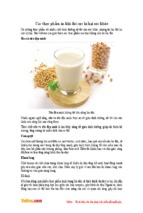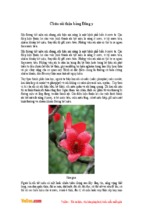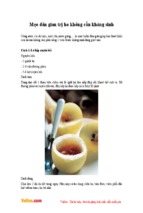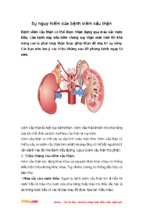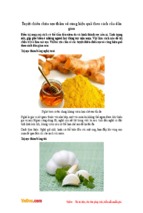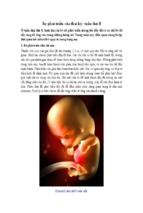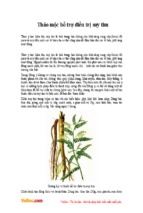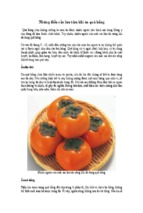Solanaceae and Convolvulaceae:
Secondary Metabolites
Eckart Eich
Solanaceae
and Convolvulaceae:
Secondary Metabolites
Biosynthesis, Chemotaxonomy,
Biological and Economic Significance
(A Handbook)
Prof. Dr. Eckart Eich
Freie Universität Berlin
Institut für Pharmazie
- Pharmazeutische Biologie Königin-Luise-Str. 2 + 4
14195 Berlin
Germany
E-mail:
[email protected]
Cover illustration: Flowers of Ipomoea purpurea (L.) Roth [cultivar; Convolvulaceae] (left)
and Solandra maxima (Sessé & Mocino) P.S. Green [Solanaceae] (right). Plotted on the
photographs are corresponding constituents: the major anthocyanin pigment and the major
alkaloid hyoscyamine, respectively.
ISBN 978-3-540-74540-2
e-ISBN 978-3-540-74541-9
The Library of Congress Control Number: 2007933490
© 2008 Springer-Verlag Berlin Heidelberg
This work is subject to copyright. All rights reserved, whether the whole or part of the material is
concerned, specifically the rights of translation, reprinting, reuse of illustrations, recitation, broadcasting, reproduction on microfilm or in any other way, and storage in data banks. Duplication of
this publication or parts thereof is permitted only under the provisions of the German Copyright Law
of September 9, 1965, in its current version, and permission for use must always be obtained from
Springer. Violations are liable for prosecution under the German Copyright Law.
The use of registered names, trademarks, etc. in this publication does not imply, even in the absence of
a specific statement, that such names are exempt from the relevant protective laws and regulations and
therefore free for general use.
Product liability: The publishers cannot guarantee the accuracy of any information about dosage and
application contained in this book. In every individual case the user must check such information by
consulting the relevant literature.
Cover design: WMXDesign GmbH, Heidelberg, Germany
Printed on acid-free paper
springer.com
SPIN 11003991
5 4 3 2 1 0
„Was du ererbt von deinen Vätern hast,
Erwirb es, um es zu besitzen.“
(All that you have, bequeathed you by your fathers,
Earn it in order to possess it.)
Johann Wolfgang von Goethe (Faust I)
This book is based on a multitude of results obtained in
botany, phytochemistry, and other biological sciences
from all over the world since the beginning of modern
research two hundred years ago. It is dedicated to all the
scientists who have contributed to these results.
Acknowledgments
This interdisciplinary book is a result of my long-standing fascination for the botany of solanaceous and convolvulaceous plants as well as their ability to synthesize
a multitude of chemical species with their biological activities. However, this book
would not have been realized without the support of the following individuals to
whom I express my sincere gratitude:
• For conscientious reading and competent commenting on the manuscript of the
book: Priv.-Doz. Dr. Kristina Jenett-Siems and Prof. Dr. Heinz H. Pertz, Freie
Universität Berlin, Germany (Chaps. 3–8), Priv.-Doz. Dr. Michael Stech,
Universiteit Leiden, The Netherlands (Chap. 2), and my daughter, Dr. Susanne
Eich-Greatorex, Universitet for miljø- og biovitenskap, Ås, Norway (Chap. 1)
• For introducing me, an ignoramus in computer affairs until 2003, to the secrets
of the personal computer and its various functions with patience and unremitting
efforts: Dr. Thomas Schimming, Berlin
• For rescue of my personal computer in severe cases of crashes: Dr. Colja
Schubert, Heinrich Hertz Institut Berlin
• For long-term botanical advice and information: Daniel F. Austin, Ph.D.,
Emeritus Professor at Florida Atlantic University, Boca Raton, and Research
Associate of the Arizona-Sonora Desert Museum, Tucson, USA
• For the excellent advice and guidance as well as for the generous acceptance of
my requests: the life sciences editorial staff of Springer, especially Dr. Jutta
Lindenborn and Dr. Dieter Czeschlik, Heidelberg, Germany and the copyeditor,
John Kirby, Malvern, UK
• For the contribution of 53 photographs to the Colour Plates of this book taken
during our common journeys through predominantly tropical countries, for the
essential support in many different respects, e.g., by proof-reading, discussions,
excellent organizing, and last but not least for the forbearance of my
preoccupation with the book and long-term encouragement: my wife, Elisabeth
Bäumel-Eich, Berlin
Berlin, August 2007
Eckart Eich
vii
Contents
1
Introduction . . . . . . . . . . . . . . . . . . . . . . . . . . . . . . . . . . . . . . . . . . . . . . .
1
1.1 Philosophy and Aims of this Book . . . . . . . . . . . . . . . . . . . . . . . . . .
1.1.1 The Large Solanales Families as a Topic . . . . . . . . . . . . . . .
1.1.2 General Role of the Secondary Metabolism
for a Specific Characterization
and Classification of Plant Taxa . . . . . . . . . . . . . . . . . . . . . .
1.1.3 Bird’s-Eye View of Two Centuries
of Phytochemical Research on Solanaceae
and Convolvulaceae. . . . . . . . . . . . . . . . . . . . . . . . . . . . . . . .
1.2 Secondary Metabolism of the Large Solanales Families . . . . . . . . .
1.2.1 Historical Background. . . . . . . . . . . . . . . . . . . . . . . . . . . . . .
1.2.2 Common Ground and Differences
of the Solanales Families. . . . . . . . . . . . . . . . . . . . . . . . . . . .
1.2.3 Similar Secondary Metabolism of the Large
Solanales Families . . . . . . . . . . . . . . . . . . . . . . . . . . . . . . . . .
1.3 Strategy . . . . . . . . . . . . . . . . . . . . . . . . . . . . . . . . . . . . . . . . . . . . . . .
1.4 Criteria for Selection of Secondary Metabolites Based
on their Specific Significance . . . . . . . . . . . . . . . . . . . . . . . . . . . . . .
1.5 Accumulation or Low-Level Occurrence
of Secondary Metabolites . . . . . . . . . . . . . . . . . . . . . . . . . . . . . . . . .
1.6 Significance of Chemotaxonomy . . . . . . . . . . . . . . . . . . . . . . . . . . .
1.7 Principal Nomenclatural Points . . . . . . . . . . . . . . . . . . . . . . . . . . . .
1.7.1 Species Names. . . . . . . . . . . . . . . . . . . . . . . . . . . . . . . . . . . .
1.7.2 Chemical Trivial Names . . . . . . . . . . . . . . . . . . . . . . . . . . . .
References . . . . . . . . . . . . . . . . . . . . . . . . . . . . . . . . . . . . . . . . . . . . . . . . .
1
1
1
2
3
3
4
5
6
6
7
8
8
8
8
9
2 Classification and System in Solanales . . . . . . . . . . . . . . . . . . . . . . . . .
11
2.1 Position of the Order Solanales and its Families . . . . . . . . . . . . . . .
2.1.1 Traditional Systematics . . . . . . . . . . . . . . . . . . . . . . . . . . . . .
2.1.2 Phylogenetic Classification Based on Predominantly
(Macro)molecular Data Sets . . . . . . . . . . . . . . . . . . . . . . . . .
11
11
12
ix
x
Contents
2.2 Solanaceae A.L. de Jussieu: Delimitation,
Intrafamilial Circumscription and Relationships . . . . . . . . . . . . . . .
2.2.1 Traditional Systematics . . . . . . . . . . . . . . . . . . . . . . . . . . . . .
2.2.2 Phylogenetic Classification Based on Predominantly
(Macro)molecular Data Sets . . . . . . . . . . . . . . . . . . . . . . . . .
2.3 Convolvulaceae A.L. de Jussieu: Delimitation, Intrafamilial
Circumscription and Relationships . . . . . . . . . . . . . . . . . . . . . . . . . .
2.3.1 Traditional Systematics . . . . . . . . . . . . . . . . . . . . . . . . . . . . .
2.3.2 Phylogenetic Classification Based on Predominantly
(Macro)molecular Data Sets . . . . . . . . . . . . . . . . . . . . . . . . .
2.4 Uncharted Territory with Regard to Secondary
Metabolites of the Solanales . . . . . . . . . . . . . . . . . . . . . . . . . . . . . . .
References . . . . . . . . . . . . . . . . . . . . . . . . . . . . . . . . . . . . . . . . . . . . . . . . .
3
15
15
16
21
22
22
23
28
Ornithine-Derived Alkaloids. . . . . . . . . . . . . . . . . . . . . . . . . . . . . . . . . .
33
3.1 Simple Pyrrolidines. . . . . . . . . . . . . . . . . . . . . . . . . . . . . . . . . . . . . .
3.1.1 Discovery and Structural Elucidation . . . . . . . . . . . . . . . . . .
3.1.2 Occurrence in the Solanaceae . . . . . . . . . . . . . . . . . . . . . . . .
3.1.3 Occurrence in the Convolvulaceae . . . . . . . . . . . . . . . . . . . .
3.1.4 Biosynthesis. . . . . . . . . . . . . . . . . . . . . . . . . . . . . . . . . . . . . .
3.1.5 Significance . . . . . . . . . . . . . . . . . . . . . . . . . . . . . . . . . . . . . .
3.2 N-Acylpyrrolidines (Pyrrolidides, Pyrrolidine Amides). . . . . . . . . .
3.2.1 Occurrence in the Solanaceae . . . . . . . . . . . . . . . . . . . . . . . .
3.2.2 Occurrence in the Convolvulaceae . . . . . . . . . . . . . . . . . . . .
3.2.3 Biosynthesis. . . . . . . . . . . . . . . . . . . . . . . . . . . . . . . . . . . . . .
3.2.4 Significance . . . . . . . . . . . . . . . . . . . . . . . . . . . . . . . . . . . . . .
3.3 Nicotinoids (Tobacco Alkaloids) . . . . . . . . . . . . . . . . . . . . . . . . . . .
3.3.1 Discovery and Structure Elucidation. . . . . . . . . . . . . . . . . . .
3.3.2 Occurrence in the Solanaceae . . . . . . . . . . . . . . . . . . . . . . . .
3.3.3 Occurrence in the Convolvulaceae . . . . . . . . . . . . . . . . . . . .
3.3.4 Biosynthesis of Pyrrolidine-Type
Nicotinoids . . . . . . . . . . . . . . . . . . . . . . . . . . . . . . . . . . . . . .
3.3.5 Biosynthesis of Piperidine-/Piperideine-Type
Nicotinoids . . . . . . . . . . . . . . . . . . . . . . . . . . . . . . . . . . . . . .
3.3.6 Significance . . . . . . . . . . . . . . . . . . . . . . . . . . . . . . . . . . . . . .
3.4 Tropanes . . . . . . . . . . . . . . . . . . . . . . . . . . . . . . . . . . . . . . . . . . . . . .
3.4.1 Discovery and Structure Elucidation. . . . . . . . . . . . . . . . . . .
3.4.2 Occurrence in the Solanaceae . . . . . . . . . . . . . . . . . . . . . . . .
3.4.3 Occurrence in the Convolvulaceae . . . . . . . . . . . . . . . . . . . .
3.4.4 Biosynthesis. . . . . . . . . . . . . . . . . . . . . . . . . . . . . . . . . . . . . .
3.4.5 Significance . . . . . . . . . . . . . . . . . . . . . . . . . . . . . . . . . . . . . .
3.5 Calystegines (Polyhydroxylated Nortropanes) . . . . . . . . . . . . . . . . .
3.5.1 Discovery and Structure Elucidation. . . . . . . . . . . . . . . . . . .
3.5.2 Occurrence in the Solanaceae . . . . . . . . . . . . . . . . . . . . . . . .
65
65
68
70
73
74
74
75
75
76
76
77
77
87
94
94
97
98
109
109
114
130
150
153
160
160
164
Contents
xi
3.5.3 Occurrence in the Convolvulaceae . . . . . . . . . . . . . . . . . . . .
3.5.4 Biosynthesis. . . . . . . . . . . . . . . . . . . . . . . . . . . . . . . . . . . . . .
3.5.5 Significance . . . . . . . . . . . . . . . . . . . . . . . . . . . . . . . . . . . . . .
3.6 Indolizidines . . . . . . . . . . . . . . . . . . . . . . . . . . . . . . . . . . . . . . . . . . .
3.7 Pyrrolizidines . . . . . . . . . . . . . . . . . . . . . . . . . . . . . . . . . . . . . . . . . .
3.7.1 Occurrence in the Convolvulaceae . . . . . . . . . . . . . . . . . . . .
3.7.2 Significance . . . . . . . . . . . . . . . . . . . . . . . . . . . . . . . . . . . . . .
References . . . . . . . . . . . . . . . . . . . . . . . . . . . . . . . . . . . . . . . . . . . . . . . . .
165
175
176
177
178
180
187
188
Tryptophan-derived Alkaloids . . . . . . . . . . . . . . . . . . . . . . . . . . . . . . . .
213
4.1 β-Carbolines . . . . . . . . . . . . . . . . . . . . . . . . . . . . . . . . . . . . . . . . . . .
4.1.1 Occurrence in the Solanaceae . . . . . . . . . . . . . . . . . . . . . . . .
4.1.2 Occurrence in the Convolvulaceae . . . . . . . . . . . . . . . . . . . .
4.2 Ergolines . . . . . . . . . . . . . . . . . . . . . . . . . . . . . . . . . . . . . . . . . . . . . .
4.2.1 Discovery and Structure . . . . . . . . . . . . . . . . . . . . . . . . . . . .
4.2.2 Biosynthesis. . . . . . . . . . . . . . . . . . . . . . . . . . . . . . . . . . . . . .
4.2.3 Occurrence in the Convolvulaceae . . . . . . . . . . . . . . . . . . . .
4.2.4 Location and Origin of Ergoline Alkaloids. . . . . . . . . . . . . .
4.2.5 Significance . . . . . . . . . . . . . . . . . . . . . . . . . . . . . . . . . . . . . .
References . . . . . . . . . . . . . . . . . . . . . . . . . . . . . . . . . . . . . . . . . . . . . . . . .
213
213
214
215
215
218
222
241
245
252
Miscellaneous Alkaloids . . . . . . . . . . . . . . . . . . . . . . . . . . . . . . . . . . . . .
261
5.1 Occurrence in the Solanaceae . . . . . . . . . . . . . . . . . . . . . . . . . . . . . .
5.1.1 Fabianine . . . . . . . . . . . . . . . . . . . . . . . . . . . . . . . . . . . . . . . .
5.1.2 2-Methoxy-3-isobutylpyrazine . . . . . . . . . . . . . . . . . . . . . . .
5.1.3 Nicotianamine . . . . . . . . . . . . . . . . . . . . . . . . . . . . . . . . . . . .
5.1.4 Solamines . . . . . . . . . . . . . . . . . . . . . . . . . . . . . . . . . . . . . . .
5.1.5 Pyrrole Alkaloids. . . . . . . . . . . . . . . . . . . . . . . . . . . . . . . . . .
5.1.6 Benzodiazepines . . . . . . . . . . . . . . . . . . . . . . . . . . . . . . . . . .
5.1.7 Catecholamines . . . . . . . . . . . . . . . . . . . . . . . . . . . . . . . . . . .
5.1.8 Betaines . . . . . . . . . . . . . . . . . . . . . . . . . . . . . . . . . . . . . . . . .
5.2 Occurrence in the Convolvulaceae . . . . . . . . . . . . . . . . . . . . . . . . . .
5.2.1 Benzylisoquinolines . . . . . . . . . . . . . . . . . . . . . . . . . . . . . . .
5.2.2 Animartinines . . . . . . . . . . . . . . . . . . . . . . . . . . . . . . . . . . . .
5.2.3 Lolines . . . . . . . . . . . . . . . . . . . . . . . . . . . . . . . . . . . . . . . . . .
5.2.4 Betaines . . . . . . . . . . . . . . . . . . . . . . . . . . . . . . . . . . . . . . . . .
5.2.5 N,N-Diacylspermidines . . . . . . . . . . . . . . . . . . . . . . . . . . . . .
References . . . . . . . . . . . . . . . . . . . . . . . . . . . . . . . . . . . . . . . . . . . . . . . . .
261
261
261
262
263
263
264
264
264
264
264
266
266
267
268
268
6 Phenylalanine-derived Metabolites / Phenylpropanoids . . . . . . . . . . .
271
6.1 N-Acylphenylethylamines and Derivatives. . . . . . . . . . . . . . . . . . . .
6.1.1 Occurrence in the Solanaceae . . . . . . . . . . . . . . . . . . . . . . . .
6.1.2 Occurrence in the Convolvulaceae . . . . . . . . . . . . . . . . . . . .
272
272
272
4
5
xii
Contents
6.2 Cyanogenic Glycosides. . . . . . . . . . . . . . . . . . . . . . . . . . . . . . . . . . .
6.2.1 Discovery, Distribution in the Plant Kingdom,
Ecological Significance . . . . . . . . . . . . . . . . . . . . . . . . . . . . .
6.2.2 Occurrence in the Convolvulaceae . . . . . . . . . . . . . . . . . . . .
6.3 Cinnamate, Hydroxycinnamates and their Derivatives
(Phenylpropanoids Sensu Latiore) . . . . . . . . . . . . . . . . . . . . . . . . . .
6.3.1 Phenylpropanoids Sensu Stricto (C6C3 Skeleton) . . . . . . . . .
6.3.2 Phenylethanoids (C6C2 Skeleton) . . . . . . . . . . . . . . . . . . . . .
6.3.3 Phenylmethanoids (C6C1 Skeleton): Benzoates,
Hydroxybenzoates, and their Derivatives . . . . . . . . . . . . . . .
6.4 Capsaicinoids . . . . . . . . . . . . . . . . . . . . . . . . . . . . . . . . . . . . . . . . . .
6.4.1 Discovery and Structure Elucidation. . . . . . . . . . . . . . . . . . .
6.4.2 Botanical Aspects . . . . . . . . . . . . . . . . . . . . . . . . . . . . . . . . .
6.4.3 Occurrence. . . . . . . . . . . . . . . . . . . . . . . . . . . . . . . . . . . . . . .
6.4.4 Biosynthesis. . . . . . . . . . . . . . . . . . . . . . . . . . . . . . . . . . . . . .
6.4.5 Significance . . . . . . . . . . . . . . . . . . . . . . . . . . . . . . . . . . . . . .
6.5 Hydroxycoumarins . . . . . . . . . . . . . . . . . . . . . . . . . . . . . . . . . . . . . .
6.5.1 Occurrence in the Solanaceae . . . . . . . . . . . . . . . . . . . . . . . .
6.5.2 Occurrence in the Convolvulaceae . . . . . . . . . . . . . . . . . . . .
6.6 Hydroxycinnamate Conjugates/Caffeic Acid Derivatives . . . . . . . .
6.6.1 Long Chain Alkyl Esters
of Hydroxycinnamic Acids . . . . . . . . . . . . . . . . . . . . . . . . . .
6.6.2 Hydroxycinnamoyl Glucose Esters
and O-Glucosides . . . . . . . . . . . . . . . . . . . . . . . . . . . . . . . . .
6.6.3 Chlorogenic Acid, Dicaffeoylquinic Acids,
and Related Caffeic Acid Derivatives . . . . . . . . . . . . . . . . . .
6.6.4 Hydroxycinnamic Acid Amides . . . . . . . . . . . . . . . . . . . . . .
6.7 Flavonoids . . . . . . . . . . . . . . . . . . . . . . . . . . . . . . . . . . . . . . . . . . . . .
6.7.1 Flavones, Flavonols, and their Derivatives . . . . . . . . . . . . . .
6.7.2 Flavonoid Sulfates . . . . . . . . . . . . . . . . . . . . . . . . . . . . . . . . .
6.7.3 Anthocyanins . . . . . . . . . . . . . . . . . . . . . . . . . . . . . . . . . . . . .
6.7.4 Isoflavonoids . . . . . . . . . . . . . . . . . . . . . . . . . . . . . . . . . . . . .
6.8 Lignans and Neolignans . . . . . . . . . . . . . . . . . . . . . . . . . . . . . . . . . .
6.8.1 Occurrence in the Solanaceae . . . . . . . . . . . . . . . . . . . . . . . .
6.8.2 Occurrence in the Convolvulaceae . . . . . . . . . . . . . . . . . . . .
References . . . . . . . . . . . . . . . . . . . . . . . . . . . . . . . . . . . . . . . . . . . . . . . . .
7
274
274
274
275
277
278
279
282
282
284
285
286
287
292
292
293
294
294
295
295
298
303
304
307
308
319
321
323
326
329
Terpenoids (Isoprenoids). . . . . . . . . . . . . . . . . . . . . . . . . . . . . . . . . . . . .
343
7.1 Hemiterpenoids (C5 Isoprenoids) . . . . . . . . . . . . . . . . . . . . . . . . . . .
7.1.1 Occurrence in the Convolvulaceae . . . . . . . . . . . . . . . . . . . .
7.2 Monoterpenoids (C10 Isoprenoids) . . . . . . . . . . . . . . . . . . . . . . . . . .
7.2.1 Occurrence in the Solanaceae . . . . . . . . . . . . . . . . . . . . . . . .
7.2.2 Occurrence in the Convolvulaceae . . . . . . . . . . . . . . . . . . . .
344
344
345
345
347
Contents
7.3 Sesquiterpenoids (C15 Isoprenoids). . . . . . . . . . . . . . . . . . . . . . . . .
7.3.1
Occurrence in the Solanaceae . . . . . . . . . . . . . . . . . . . . . .
7.3.2
Occurrence in the Convolvulaceae . . . . . . . . . . . . . . . . . .
7.4 Diterpenoids (C20 Isoprenoids) . . . . . . . . . . . . . . . . . . . . . . . . . . . .
7.4.1
Occurrence in the Solanaceae . . . . . . . . . . . . . . . . . . . . . .
7.4.2
Occurrence in the Convolvulaceae . . . . . . . . . . . . . . . . . .
7.5 Triterpenoids (C30 Isoprenoids). . . . . . . . . . . . . . . . . . . . . . . . . . . .
7.5.1 Occurrence in the Solanaceae . . . . . . . . . . . . . . . . . . . . . .
7.5.2 Occurrence in the Convolvulaceae . . . . . . . . . . . . . . . . . .
7.6 Phytosterols (C27–C29 Isoprenoids) . . . . . . . . . . . . . . . . . . . . . . . . .
7.6.1 Occurrence in the Solanaceae . . . . . . . . . . . . . . . . . . . . . .
7.6.2 Occurrence in the Convolvulaceae . . . . . . . . . . . . . . . . . .
7.7 Steroidal Sapogenins/Saponins (C27 Isoprenoids) . . . . . . . . . . . . .
7.7.1
Discovery and Structure Elucidation . . . . . . . . . . . . . . . .
7.7.2
Occurrence in the Solanaceae . . . . . . . . . . . . . . . . . . . . . .
7.7.3
Biosynthesis . . . . . . . . . . . . . . . . . . . . . . . . . . . . . . . . . . .
7.7.4
Significance. . . . . . . . . . . . . . . . . . . . . . . . . . . . . . . . . . . .
7.8 Steroidal Alkaloids/Glycoalkaloids (C27 Isoprenoids) . . . . . . . . . .
7.8.1
Discovery and Structure Elucidation . . . . . . . . . . . . . . . .
7.8.2
Occurrence in the Solanaceae . . . . . . . . . . . . . . . . . . . . . .
7.8.3
Biosynthesis . . . . . . . . . . . . . . . . . . . . . . . . . . . . . . . . . . .
7.8.4
Significance. . . . . . . . . . . . . . . . . . . . . . . . . . . . . . . . . . . .
7.9 Miscellaneous Rare Steroidal Metabolites . . . . . . . . . . . . . . . . . . .
7.9.1 Homo-cholestane Glycosides (C27 + C2 /C3 ). . . . . . . . . . .
7.9.2
Cardenolides . . . . . . . . . . . . . . . . . . . . . . . . . . . . . . . . . . .
7.9.3
Cholecalciferol/Vitamin D3 and Congeners
(C27 Isoprenoids) . . . . . . . . . . . . . . . . . . . . . . . . . . . . . . . .
7.9.4
Estrogens (C18 Isoprenoids) . . . . . . . . . . . . . . . . . . . . . . .
7.9.5
Ecdysteroids and Antagonists . . . . . . . . . . . . . . . . . . . . . .
7.9.6
Brassinosteroids (C27 + C1 /C2 Isoprenoids) . . . . . . . . . . .
7.10 Withanolides/Withasteroids (C28 Isoprenoids) . . . . . . . . . . . . . . . .
7.10.1 Discovery . . . . . . . . . . . . . . . . . . . . . . . . . . . . . . . . . . . . .
7.10.2 Structure . . . . . . . . . . . . . . . . . . . . . . . . . . . . . . . . . . . . . .
7.10.3 Occurrence in the Solanaceae . . . . . . . . . . . . . . . . . . . . . .
7.10.4 Biosynthesis . . . . . . . . . . . . . . . . . . . . . . . . . . . . . . . . . . .
7.10.5 Significance. . . . . . . . . . . . . . . . . . . . . . . . . . . . . . . . . . . .
7.11 Petuniasteroids (C28 Isoprenoids) . . . . . . . . . . . . . . . . . . . . . . . . . .
7.11.1 Discovery and Structures . . . . . . . . . . . . . . . . . . . . . . . . .
7.11.2 Ecological Significance. . . . . . . . . . . . . . . . . . . . . . . . . . .
7.12 Tetraterpenoids/Carotenoids (C40 Isoprenoids) . . . . . . . . . . . . . . . .
7.12.1 Solanaceae. . . . . . . . . . . . . . . . . . . . . . . . . . . . . . . . . . . . .
7.12.2 Convolvulaceae . . . . . . . . . . . . . . . . . . . . . . . . . . . . . . . . .
7.12.3 Significance. . . . . . . . . . . . . . . . . . . . . . . . . . . . . . . . . . . .
References . . . . . . . . . . . . . . . . . . . . . . . . . . . . . . . . . . . . . . . . . . . . . . . . .
xiii
348
348
356
359
361
365
366
366
368
368
370
372
372
376
386
393
395
399
412
425
441
447
460
460
460
461
464
464
465
466
466
471
479
480
480
483
483
486
486
487
493
494
495
xiv
Contents
8 Secondary Metabolites Derived from Fatty Acids
and Carbohydrates . . . . . . . . . . . . . . . . . . . . . . . . . . . . . . . . . . . . . . . . . 525
8.1 Fatty Acids and Their Derivatives . . . . . . . . . . . . . . . . . . . . . . . . . .
8.1.1 Fatty Acids. . . . . . . . . . . . . . . . . . . . . . . . . . . . . . . . . . . . . . .
8.1.2 Fatty Acid Amides and Aliphatic Monoamines . . . . . . . . . .
8.2 Secondary Carbohydrates . . . . . . . . . . . . . . . . . . . . . . . . . . . . . . . . .
8.2.1 Occurrence in the Solanaceae . . . . . . . . . . . . . . . . . . . . . . . .
8.2.2 Occurrence in the Convolvulaceae . . . . . . . . . . . . . . . . . . . .
8.3 Resin Glycosides (Glycoresins) . . . . . . . . . . . . . . . . . . . . . . . . . . . .
8.3.1 Discovery and Structural Elucidation . . . . . . . . . . . . . . . . . .
8.3.2 Occurrence in the Convolvulaceae . . . . . . . . . . . . . . . . . . . .
8.3.3 Significance . . . . . . . . . . . . . . . . . . . . . . . . . . . . . . . . . . . . . .
8.3.4 Convolvulaceous Resin Glycosides versus
Solanaceous Steroidal Glycoalkaloids . . . . . . . . . . . . . . . . .
References . . . . . . . . . . . . . . . . . . . . . . . . . . . . . . . . . . . . . . . . . . . . . . . . .
525
525
527
529
529
531
532
532
562
564
Appendix: Color Plates of Solanales Species . . . . . . . . . . . . . . . . . . . . . . .
583
572
573
Subject Index . . . . . . . . . . . . . . . . . . . . . . . . . . . . . . . . . . . . . . . . . . . . . . . . . 607
Taxonomic Index . . . . . . . . . . . . . . . . . . . . . . . . . . . . . . . . . . . . . . . . . . . . . . 625
1
Introduction
1.1 Philosophy and Aims of this Book
1.1.1 The Large Solanales Families as a Topic
Solanales are from the Mid-Cretaceous (stem node age: 106 my; crown node age:
100 my) (Bremer et al. 2004). Solanaceae and Convolvulaceae are sisters representing the two large families of this order. Their last common ancestor lived about 70
my ago (Durbin et al. 2000). The main objective of the author is to focus on aspects
of our extensive knowledge of secondary metabolites in the plant kingdom in order
to account for the specific competitiveness and productivity of these two large
Solanales families. To this end, it has been necessary to take a bird’s-eye view of
200 years of phytochemical research on the Solanales, since first scientific reports
with regard to both families were published in the early nineteenth century. Due to
an almost complete lack of phytochemical reports (one single exception) on species
of the three remaining, very small families of the order (see Chap. 2), they have not
been considered.
1.1.2 General Role of the Secondary Metabolism for a Specific
Characterization and Classification of Plant Taxa
While traditional systematics generally focused on morphologic-anatomical characters of plants, in some cases chemotaxonomic aspects with regard to low molecular
secondary metabolites were also considered. However, plant biochemistry and
chemotaxonomy normally played a minor role in classification. In contrast, phylogenetic approaches to plant systematics, based on (macro)molecular cladistic analyses, have received an extraordinary, increasing significance during the past 25 years
(e.g., Judd et al. 1999). In the author’s opinion, our extensive knowledge of
secondary metabolites has not yet been integrated into the characterization of plant
families, genera, and species to an extent appropriate to its significance. There are
enormous numbers of flora from all over the world which document and maintain in
Eckart Eich, Solanaceae and Convolvulaceae: Secondary Metabolites
© Springer-Verlag Berlin Heidelberg 2008
1
2
1 Introduction
detail the morphologic-anatomical characters of the different taxa as well as their
phytogeographic distribution. There are also extensive, daily growing databases
available on specific DNA sequences of many plant species or even on their whole
genome. These fields of botanical sciences have been used to characterize plants,
especially on the species level.
On the other hand, plant biochemistry is still playing a minor role with regard to
the specific characterization of plants. The primary metabolism of plants is more or
less ubiquitously the same with few exceptions, e.g., C3 vs C4 plants. Therefore, it
is of minor if any use for the characterization of the different taxa. The secondary
metabolism as far as low-molecular constituents are concerned can add further
important information to the characterization of taxa on different levels. Normal
flora written for geographically restricted areas only occasionally included some
information on secondary metabolites, e.g., “Flore de Madagascar et des Comores,
famille 171, Convolvulaceae” on two pages (Deroin 2001). As a rare exception, the
comprehensive monograph “Genera Solanacearum” (Hunziker 2001), based traditionally on morphologic/anatomical characters plus detailed information on chromosome numbers, also included aspects of the secondary metabolism – fortunately
from the phytochemical point of view. As well as a short initial overview of the
phytochemistry of the family, some limited but valuable information predominantly on groups/subgroups of secondary metabolites nested within the corresponding genera sections – exactly documented by references – were given. However,
this information is more genus-orientated, i.e., not species-specific.
1.1.3 Bird’s-Eye View of Two Centuries of Phytochemical
Research on Solanaceae and Convolvulaceae
The author wants to place far greater emphasis on the integration of specific biochemistry into the individual characterization of taxa in the field of the two large
Solanales families. In so doing, he is trying to contribute to a more interdisciplinary
way of looking at things by combining botanical and chemical sciences. Chemical
characters identified in single species in countless chemistry-oriented papers are
not really noticed by botanists though they may be of additional value for the characterization of the respective species. It is of little use to note that a species or any
other taxon contains, e.g., “alkaloids” or – slightly more specific – “tropane alkaloids”. There are tens of thousands of alkaloids and hundreds of tropane alkaloids.
The presence or absence of any single alkaloid or any other metabolite is a specific
character and may contribute to the characterization of a taxon.
Similar to other characters, e.g., morphological ones, it must be taken into
account that there may be qualitative and quantitative differences in any species
due to intraspecific, ontogenetic, and morphogenetic variability, respectively.
Furthermore, from the ecological point of view, differentiation is necessary; it is
usually not a class/group of metabolites which is associated with a certain activity. In
contrast, two structurally closely related compounds may show clearly different effects.
1.2 Secondary Metabolism of the Large Solanales Families
3
Every single alkaloid as well as any other metabolite is more or less “bioactive” but in
individually diverging qualities (effects, mechanisms of action). Its individual potency
and its content (high or low accumulation or presence in traces) in the living plant species are of considerable significance. To come back to the example of tropane alkaloids,
only a small subgroup of them (3α-tropoyloxytropanes and closely related congeners
such as hyoscyamine/atropine) is highly poisonous due to an anticholinergic potency.
The vast majority of tropane alkaloids do not possess this property.
Due to their relationship with botany and chemistry, other disciplines, such as
pharmacognosy, pharmacology/toxicology, agricultural and food sciences, ecology
etc., also play a part in this interdisciplinary approach.
Therefore, the author’s objectives are to
●
●
●
●
●
●
Document the secondary metabolites of the Solanaceae and Convolvulaceae
discovered and structurally elucidated in 200 years of phytochemical research as
far as low-molecular compounds (“small molecules”) are concerned
Describe the peculiarities of their secondary metabolism as compared to other
plants in the plant kingdom, with main focus on angiosperms
Show common features in secondary metabolism of both families, as well as
their chemotaxonomic relationships
Demonstrate the special qualities of the family Solanaceae vs the family
Convolvulaceae, i.e., their differences
Compare the special qualities on different intrafamilial taxonomic levels (subfamilies, tribes, genera, subgenera, species) of both families, in certain cases also
on different intraspecific taxonomic levels (subspecies, sections) of both families
Consider and integrate the ecological, pharmacological/toxicological, and economic significance of metabolites from both families
1.2 Secondary Metabolism of the Large Solanales Families
1.2.1
Historical Background
The discovery of morphine as the sleep-inducing principle (“principium somniferum”) of the opium poppy, Papaver somniferum L. (Papaveraceae), by the
German apothecary Friedrich Wilhelm Sertürner (1783–1841) in 1805 is of particular significance in the history of organic chemistry. It represented not only the
first isolation of a basic plant metabolite, but also at least one of the first isolations
of a secondary metabolite in the plant kingdom at all (Sertürner 1805; 1817). It
was the initial and stimulating step in the search for further basic constituents.
Particularly toxic plants have been screened for such compounds, which were
named “alkaloids” (alkali-like) according to the proposal of Meissner (1819). It
was therefore natural to look at poisonous species like the solanaceous herbs
Solanum nigrum (black nightshade), Nicotiana tabacum L. (Virginian tobacco),
and Atropa belladonna L. (deadly nightshade or poison black cherry). Thus, at the
4
1 Introduction
beginning of scientific research on secondary plant metabolism the relationship
between natural compounds and their toxicological/pharmacological/ecological
significance led to the isolation and – many decades later – structure elucidation
of these compounds. Over the past two centuries this principle has revealed the
majority of secondary plant metabolites, i.e., discoveries by “bioassay-guided
fractionation/isolation”, the corresponding term in modern methodology of phytochemistry. Of course, this has been true not only for alkaloids – though they represent a huge class of secondary metabolites which are especially suitable for this
method due to their particularly distinctive biological activities – but also for all
other classes of secondary metabolites. The isolation of solanine (Desfosses 1820,
1821), nicotine (Posselt and Reimann 1828), and atropine (Mein 1833; Geiger and
Hesse 1833a, b) from the three species mentioned above represented the first alkaloids from the Solanaceae and also their first secondary metabolites in general. A
century later, the very first alkaloid from the Convolvulaceae, the 3α-acyloxytropane
convolvine, was discovered as a constituent of Convolvulus pseudocantabricus
Schrenk. (Orechoff and Konowalowa 1933). Resin glycosides (glycoresins)
belong to the early discoveries in this family, e.g., in Ipomoea purga (Wender.)
Hayne, Mexican jalap (Cadet de Gassicourt 1817) and I. orizabensis, Mexican
scammony (Pellet.) Led. ex Steud. (Johnston 1840). Again, pharmacological
reasons led to the isolation of products from plant material, in this case a complex
mixture of structurally related resin glycosides as was found later (Mexican jalap
resin and Mexican scammonium resin, respectively).
1.2.2 Common Ground and Differences
of the Solanales Families
Solanaceae and Convolvulaceae share a number of obvious characters, properties,
and other factors, most of them not very surprising due to the fact that they are
sisters and a few perhaps only by pure chance:
●
●
●
●
●
●
●
●
Common phylogeny
Morphologic-anatomical similarities
Similar phytogeographic distribution
Similar secondary metabolism
Similar order of magnitude of species in the family (~2500 vs ~1800 species)
One genus dominating by far (Solanum ~1400 species vs Ipomoea ~650 species)
One economically very important food plant containing starch in the tuber
[Solanum tuberosum L. vs Ipomoea batatas (L.) Lam.]
A remarkable number of popular ornamentals – though not suitable as cut flowers, e.g., from the genera Brugmansia, Brunfelsia, Petunia, Solandra, Solanum
vs. Argyreia, Convolvulus, Evolvulus, Ipomoea, Merremia
Of course, the fourth point is the decisive one with respect to the objective of this
book. Therefore, it shall be presented in more detail.
1.2 Secondary Metabolism of the Large Solanales Families
5
1.2.3 Similar Secondary Metabolism of the Large
Solanales Families
Of course, classes/groups of metabolites which occur (almost) ubiquitously or at
least frequently in the plant kingdom (“general secondary metabolites”) are also
constituents of both large Solanales families: (i) phenolics such as simple cinnamic
acid derivatives (Sect. 6.4), hydroxycoumarins (Sect. 6.6), hydroxycinnamate conjugates (Sect. 6.7), flavonoids (Sect. 6.8), lignans (Sect. 6.9), (ii) sterols (Sect. 7.6),
(iii) carotenoids (Sect. 7.12), (iv) fats/oils and fatty acids (Sect. 8.1), (v) carbohydrates (Sect. 8.2) etc.
In addition, they share classes/groups of metabolites which occur rarely in the
plant kingdom (“specific secondary metabolites”):
●
●
The extensive class of ornithine-derived alkaloids such as hygrines, Nacylpyrrolidines, nicotinoids, tropanes, calystegines (Sects. 3.1–3.5)
Sesquiterpenoid phytoalexins (Sect. 7.3)
On the other hand, they have in common the absence of the following classes
although those are frequent constituents of closely related families also belonging
to the lamiids (euasterids I):
●
●
●
Iridoids (constituents of Apocynaceae, Gentianaceae, Lamiaceae, Rubiaceae)
Volatile oils (essential oils), complex mixtures of lipophilic mono-/sesquiterpenes
and/or phenylpropanoids secreted in oil cells, secretion ducts/cavities or glandular hairs (constituents of Lamiaceae)
Condensed tannins (proanthocyanidins; constituents of Rubiaceae)
The following groups lacking in Convolvulaceae represent specific secondary
metabolites of certain solanaceous taxa:
●
●
●
●
Capsaicinoids (Sect. 6.5)
Steroidal saponins (Sect. 7.7)
Steroidal alkaloids (Sect. 7.8)
Withasteroids (Sect. 7.10)
On the other hand, the following groups lacking in Solanaceae represent specific
secondary metabolites of certain convolvulaceous taxa:
●
●
●
●
Indolizidine alkaloids (Sect. 3.6)
Pyrrolizidine alkaloids (Sect. 3.7)
Ergolines (Sect. 4.2)
Resin glycosides (glycoresins) (Sect. 8.3)
Erratically occurring specific secondary metabolites, e.g., (i) β-carbolines in
both families (Sect. 4.1), (ii) cardenolides (Sect. 7.9.2), in the Solanaceae or (iii) 2alkylpiperidines (animartinines; Sect. 5.2.2), serotonin-hydroxycinnamic acid
amides (ipobscurines; Sect. 6.7.4) in the Convolvulaceae, are not taken into
consideration here.
6
1 Introduction
1.3
Strategy
Phytochemical studies, published in thousands upon thousands of original reports
over two centuries, have produced detailed knowledge on such a huge amount of
metabolites in both families that it would be impossible to integrate it all into this
monograph. Therefore, it is obvious to attach great significance to those phytochemical characters identified above as specific secondary metabolites (definition:
Sect. 1.2.3). Such chapters/sections are the centre of attention in this book resulting
in a correspondingly comprehensive treatment. Consequently, limitations were necessary as far as general secondary metabolites (definition: Sect. 1.2.3) were concerned. It has to be added that the existence or lack of recent reviews on a class/group
of metabolites in the literature has been another point of consideration in the present
book, i.e., a lack of recent reviews has stimulated a more extensive treatment.
1.4 Criteria for Selection of Secondary Metabolites Based
on their Specific Significance
The author is well aware of the subjectivity of his selection. Nevertheless, he hopes
that it is comprehensible. Due to the frequency of their occurrence, general
secondary metabolites are of limited value for the characterization of any taxon
independent on its level (family, genus, species) – in contrast to specific secondary
metabolites. General secondary metabolites may be interpreted as plesiomorphic
characters, whereas derived secondary metabolites apparently represent apomorphic characters. Of course, this also implies that, from the evolutionary point of
view, the former early products may have been lost in certain taxa during the evolution of the plant kingdom. Thus, e.g., simple lignans – low-molecular congeners of
lignin macromolecules – are frequent though not ubiquitous constituents of living
angiosperms. From the phylogenetic point of view, loss of a plesiomorphic characters may also be evaluated like an apomorphic character in cladistic analyses. This
is – in a figurative way – also true for the phytochemical characterization of a
taxon: Also absence of a general secondary metabolite or a class/group of such may
contribute to the characterization of a certain taxon.
However, there is no doubt that the presence of specific secondary metabolites
makes a much more valuable contribution. Consequently, the following criteria for the
selection of secondary metabolites to receive a more detailed treatment in this book
reflect this opinion. However, it is necessary to take into account additional aspects:
●
Criteria of plant-characterizing and chemotaxonomic significance
°
Specific secondary metabolites or groups of such confined to certain taxa of
one or both large Solanales families (“unique secondary metabolites”), e.g.,
3α-tropoyloxytropanes (Sect. 3.4), resin glycosides (Sect. 8.3), sesquiterpenoid phytoalexins (Sect. 7.3)
1.5 Accumulation or Low-Level Occurrence of Secondary Metabolites
7
Specific secondary metabolites or groups of such occurring in certain taxa of
one or both large Solanales families but also in a restricted number of taxa
outside the Solanales, e.g., steroidal alkaloids (Sect. 7.8), pyrrolizidine alkaloids (Sect. 3.7), calystegines (Sect. 3.6)
°
Specific secondary metabolites or groups of such derived from classes/
groups of general secondary metabolites. Such specific secondary metabolites are confined to certain taxa of one or both Solanales families – in contrast to their generally/frequently occurring congeners, e.g., certain
lignanamides (jacpaniculines) in Jacquemontia paniculata or certain sesquilignans (bonaspectins) in Bonamia spectabilis (both Convolvulaceae; Sect.
6.9.3) in contrast to members of the same class which belong to general secondary metabolites, i.e., frequently occurring in the plant kingdom, such as
pinoresinol- or dibenzylbutyrolactone-type lignans
The criterion of size of a special taxon (e.g., number of species of a certain
genus) – though only if sufficient phytochemical data are available – e.g., genera
Solanum/Nicotiana and Ipomoea/Convolvulus, respectively
Criteria of ecological significance, e.g., nicotinoids (Sect. 3.3), calystegines
(Sect. 3.5), ergolines (Sect. 4.2)
Criteria of pharmacological/toxicological significance, e.g., hyoscyamine/atropine (Sect. 3.4), nicotine (Sect. 3.3)
Criteria of economic significance (economically useful plants: food plants,
safety of food plants, production of pure drugs, tobacco products etc.), e.g., capsaicinoids (Sect. 6.5), steroidal alkaloids (Sect. 7.8), hyoscyamine/atropine
(Sect. 3.4), nicotine (Sect. 3.3)
°
●
●
●
●
1.5 Accumulation or Low-Level Occurrence
of Secondary Metabolites
Another important point with regard to characterization is the question of whether a
certain constitutive metabolite or a group of such is accumulated in a certain species
or whether it is only present in a very low concentration. Accumulation of constitutive metabolites is advantageous, e.g., for defence against herbivores, microorganisms, viruses, or plant competitors. However, modern analytical methods such as
GC/MS elucidated that many metabolites are present in very low concentrations in
one taxon in contrast to their accumulation in another, closely related one. Such cases
demonstrate that the principal ability to synthesize a certain compound is given for,
e.g., an individual species though this metabolite is not really “used” due to differential expression of the corresponding genes. A species may be rendered poisonous
only by accumulation of, e.g., a major alkaloid. However, both accumulation as well
as the principal ability to synthesize a certain metabolite – even if only in low
amounts – contributes to the phytochemical characterization of a taxon. Accumulation
8
1 Introduction
is another character exceeding a simple low-level presence; therefore, it may be considered as an additional contribution to the characterization of a taxon.
1.6 Significance of Chemotaxonomy
According to Cronquist, cited by Spring and Buschmann (1998) “….. chemical
characters are like other characters: they work when they work, and they don’t
work when they don’t work. Like all taxonomic characters, they attain their value
through correlation with other characters, and perfect correlations are the exception
rather than the rule.” Based on comprehensive studies with regard to Fabaceae,
Solanaceae, and Lamiaceae, Wink (2003) concluded “The inconsistent secondary
metabolite profiles mean that the systematic value of chemical characters become
a matter of interpretation in the same way as traditional morphological markers.
Thus, the distribution of secondary metabolites has some value for taxonomy but
their occurrence apparently reflects adaptations and particular life strategies
embedded in a given framework.”
1.7 Principal Nomenclatural Points
1.7.1
Species Names
“Worldwide, not all authors of research papers use the currently accepted name, so
caution is necessary and botanical sources should be checked” (Trease and Evans
2002). The author of the present book has tried to meet these requirements to the
best of his knowledge. Apparently invalid names used in original reports have been
supplied by valid ones, e.g., the species termed in the original reference Lycopersicon
esculentum is cited as Solanum lycopersicum L. sub nom. Lycopersicon esculentum
Mill. Unfortunately, species epithetons lack the respective authorities in the majority of phytochemical reports. This sometimes led to equivocal situations. As far as
possible the corresponding authorities have been added to each species. If species
are listed in tables, the authorities are added there but not in the corresponding part
of the text.
1.7.2 Chemical Trivial Names
For practical reasons, trivial names for secondary metabolites rather than names
according to systematic rules of the IUPAC or Chemical Abstracts have been
widely accepted in plant biochemistry. This is also the case for Chemical Abstracts


